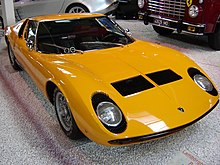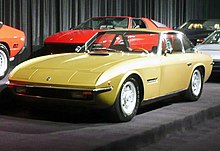1969–1970
Bertone was able to persuade Lamborghini to allow them to design a brand-new four-seater. The shape was penned by Marcello Gandini, and a bodyshell delivered to Ferruccio for inspection. The businessman was less than pleased with the enormous gullwing doors that Gandini had included, and insisted that the car would have to feature conventional doors. The car that resulted from the collaboration was debuted at the 1969 Geneva show with the name Espada, powered by a 3.9-litre, front-mounted evolution of the factory's V12, producing 325 bhp. The Espada was a runaway success, with a total production run of 1,217 cars over ten years of production.
In 1969, Automobili Lamborghini encountered problems with its fully unionized work force, among which the machinists and fabricators had begun to take one-hour token stoppages as part of a national campaign due to strained relations between the metal workers' union and Italian industry. Ferruccio Lamborghini, who often rolled up his sleeves and joined in the work on the factory floor, was able to motivate his staff to continue working towards their common goal despite the disruptions.
Throughout that year, Lamborghini's product range, then consisting of the Islero, the Espada, and the Miura S, received upgrades across the board, with the Miura receiving a power boost, the Islero being upgraded to "S" trim, and the Espada gaining comfort and performance upgrades which allowed it to reach speeds of up to 160 mph (260 km/h). The Islero was slated to be replaced by a shortened yet higher-performing version of the Espada, the Jarama 400GT. The 3.9-litre V12 was retained, its compression ratio increasing to 10.5:1.
By the time the Jarama was unveiled at the 1970 Geneva show, Paulo Stanzani was at work on a new clean-sheet design, which would use no parts from previous Lamborghini cars. Changes in tax laws and a desire to make full use of the factory's manufacturing capacity meant that the Italian automaker would follow the direction taken by Ferrari, with its Dino 246 and Porsche, with its 911, and produce a smaller, V8-powered 2+2 car, the Urraco. The 2+2 body style was selected as a concession to practicality, with Ferruccio acknowledging that Urraco owners might have children. The single overhead cam V8 designed by Stanzani produced 220 bhp at 5000 rpm. Bob Wallace immediately began road testing and development; the car was to be presented at the 1970 Turin motor show.
In 1970, Lamborghini began development of a replacement for the Miura, which was a pioneering model, but had interior noise levels that Ferruccio Lamborghini found unacceptable and nonconforming to his brand philosophy. Engineers designed a new, longer chassis that placed the engine longitudinally, further away from the driver's seat. Designated the LP500 for its 4.97-litre version of the company's V12, the prototype was styled by Marcello Gandini at Bertone. The car that was presented was debuted at the 1971 Geneva Motor Show, alongside the final revision of the Miura, the P400SuperVeloce. Completing the Lamborghini range were the Espada 2, the Urraco P250, and the Jarama GT.








